

Until World War II the important American galleries exhibited only the work of European artists. American artists were simply not taken seriously; it was believed that one had to go to Europe to be a real artist. Those American artists that didn't go to Paris turned inward, creating work mainly for themselves and each other. The trend in the years between World WarI and World War II was toward the development of private styles. Artists came to have contempt for a public that had contempt for them; they gave up on the idea of communicating to a broad audience. At the same time they studied avidly the philosophers of modernism. They read the writings of surrealist intellectuals such as Andre Breton, and Abstract painter Wassily Kandinsky's tract on abstraction Concerning the Spiritual in Art .
 They
took these philosophies to heart, especially the ideas of Surrealism. As the
Nazis drove dissenters out of Europe, many artists fled to the US. This exodus
(which also included leading Surrealists and others) contributed to the development
of the first indigenous American Art movement, Abstract
Expressionism . The result was the development of private styles,
based in the subconscious, and reached through dreams, mythic images, and reinforced
by imagery drawn from archaeology, primitive art, mysterious ancient inscriptions,
and the like.
Willem de Kooning and
Jackson Pollock were the leaders of this new American movement. Out of
the extremely varied work of the Abstract expressionists there developed a group
of artists working in quite diverse styles, which became known as the New York
School. This group included
Rothko, Motherwell,
Gottlieb, Morris Lewis,
Jasper Johns, and others.
They
took these philosophies to heart, especially the ideas of Surrealism. As the
Nazis drove dissenters out of Europe, many artists fled to the US. This exodus
(which also included leading Surrealists and others) contributed to the development
of the first indigenous American Art movement, Abstract
Expressionism . The result was the development of private styles,
based in the subconscious, and reached through dreams, mythic images, and reinforced
by imagery drawn from archaeology, primitive art, mysterious ancient inscriptions,
and the like.
Willem de Kooning and
Jackson Pollock were the leaders of this new American movement. Out of
the extremely varied work of the Abstract expressionists there developed a group
of artists working in quite diverse styles, which became known as the New York
School. This group included
Rothko, Motherwell,
Gottlieb, Morris Lewis,
Jasper Johns, and others.
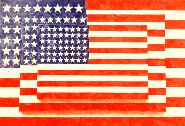 From World War II on Americans would be the groundbreakers for new artistic
styles.
From World War II on Americans would be the groundbreakers for new artistic
styles.
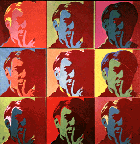 Pop
art is an art form based in the power of popular images, derived
from the commercial and mass media sources that permeate modern American society.
By elevating the banal to the status of Art, the viewer is challenged to reconsider
the nature of society and its values.
Andy
Warhol's soup cans, coke bottles, and movie stars are the best known examples.
Roy
Lichtenstein uses comic book imagery and style, creating bold images that
are undeniably part of the American lexicon. Artists such as
Claes
Oldenburg focus our attention on every day objects by blowing them up to
enormous size.
Pop
art is an art form based in the power of popular images, derived
from the commercial and mass media sources that permeate modern American society.
By elevating the banal to the status of Art, the viewer is challenged to reconsider
the nature of society and its values.
Andy
Warhol's soup cans, coke bottles, and movie stars are the best known examples.
Roy
Lichtenstein uses comic book imagery and style, creating bold images that
are undeniably part of the American lexicon. Artists such as
Claes
Oldenburg focus our attention on every day objects by blowing them up to
enormous size.

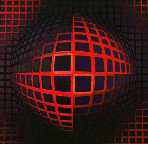 Op
art is a term used to refer to a style of nonobjective art in which
optical effects of color relationships and formal relationships are the primary
subject matter. These works are characterized by intricate, usually geometric
patterns and carefully calibrated colors. Among the artists known for this style
are Bridget Riley
and
Vasareley. This very intellectual approach shows a relationship with
the earlier de Stijl ideas about the aesthetics and expressive power of pure
form and color.
Op
art is a term used to refer to a style of nonobjective art in which
optical effects of color relationships and formal relationships are the primary
subject matter. These works are characterized by intricate, usually geometric
patterns and carefully calibrated colors. Among the artists known for this style
are Bridget Riley
and
Vasareley. This very intellectual approach shows a relationship with
the earlier de Stijl ideas about the aesthetics and expressive power of pure
form and color.
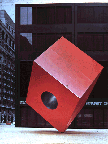 Minimalism grew out of Op Art, a logical extension of the obliteration
of subject matter. Painting and sculpture are reduced to essential forms without
embellishment or complication.
Ellsworth
Kelly, Robert Grosvenor,
Isamu
Noguchi, and Frank
Stella were among its practitioners.
Minimalism grew out of Op Art, a logical extension of the obliteration
of subject matter. Painting and sculpture are reduced to essential forms without
embellishment or complication.
Ellsworth
Kelly, Robert Grosvenor,
Isamu
Noguchi, and Frank
Stella were among its practitioners.
Conceptual art is rooted in the DaDa movement of the early 1920's, in
that it attacks the sacredness and permanence of the artwork itself, claiming
that the art is in the idea, and that once the concept has been expressed, the
object is unimportant.
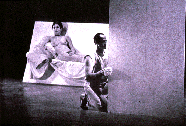 Some
forms of conceptual art involve temporary installations in galleries or other
public places, such as arrangements of lumber, or bricks, or other materials.
A gallery in one instance was transformed into a tremendous birdcage filled
with live birds and other objects.
Some
forms of conceptual art involve temporary installations in galleries or other
public places, such as arrangements of lumber, or bricks, or other materials.
A gallery in one instance was transformed into a tremendous birdcage filled
with live birds and other objects.
A special form of conceptual art is performance art, in which art media and
other objects are blended with theatrical or musical performance.
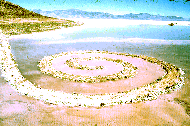 Environmental
art can involve large scale installations or earthworks, such as a field of
lightning rods, or
Robert Smithsons "Spiral Jetty" or
Christo'swrapped environments (click on "Some Artworks at top left and select). A contemporary environmental artist
who has actually done projects here at Cornell is
Andy Goldsworthy
(scroll down for images.
In addition to the images on the previous link, take a look at this video clip of Goldsworthy
at work from a
documentary "Rivers and Tides."
Environmental
art can involve large scale installations or earthworks, such as a field of
lightning rods, or
Robert Smithsons "Spiral Jetty" or
Christo'swrapped environments (click on "Some Artworks at top left and select). A contemporary environmental artist
who has actually done projects here at Cornell is
Andy Goldsworthy
(scroll down for images.
In addition to the images on the previous link, take a look at this video clip of Goldsworthy
at work from a
documentary "Rivers and Tides."
Electronic media The new technologies of the information age
are creating entirely new opportunities for artists.
Virtual reality
refers to forms of computer animation that permit the viewer the illusion of moving through the
visual space.
Interactive multimedia, can combine poetry, theater, music, dance,video and more.
 |